Bruno Golosio
Scalable Construction of Spiking Neural Networks using up to thousands of GPUs
Dec 10, 2025Abstract:Diverse scientific and engineering research areas deal with discrete, time-stamped changes in large systems of interacting delay differential equations. Simulating such complex systems at scale on high-performance computing clusters demands efficient management of communication and memory. Inspired by the human cerebral cortex -- a sparsely connected network of $\mathcal{O}(10^{10})$ neurons, each forming $\mathcal{O}(10^{3})$--$\mathcal{O}(10^{4})$ synapses and communicating via short electrical pulses called spikes -- we study the simulation of large-scale spiking neural networks for computational neuroscience research. This work presents a novel network construction method for multi-GPU clusters and upcoming exascale supercomputers using the Message Passing Interface (MPI), where each process builds its local connectivity and prepares the data structures for efficient spike exchange across the cluster during state propagation. We demonstrate scaling performance of two cortical models using point-to-point and collective communication, respectively.
Runtime Construction of Large-Scale Spiking Neuronal Network Models on GPU Devices
Jun 16, 2023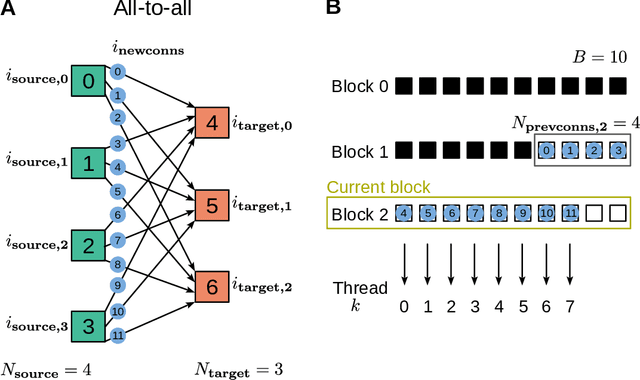
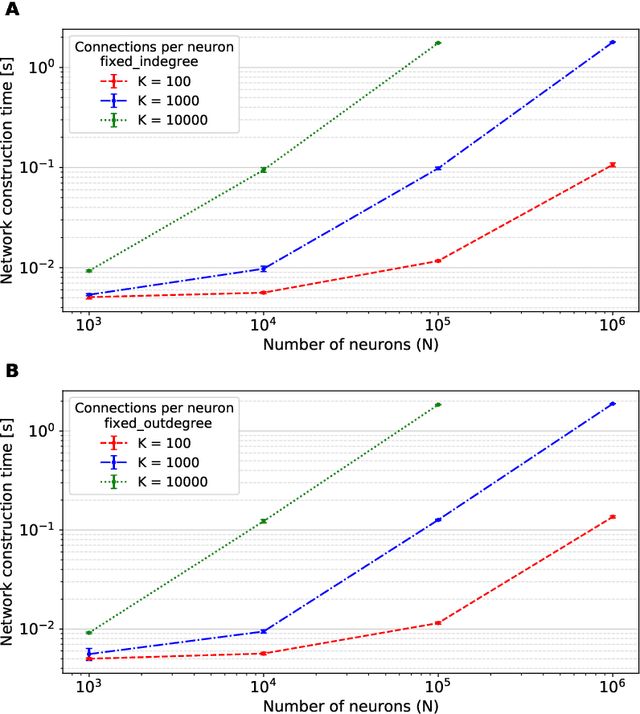


Abstract:Simulation speed matters for neuroscientific research: this includes not only how quickly the simulated model time of a large-scale spiking neuronal network progresses, but also how long it takes to instantiate the network model in computer memory. On the hardware side, acceleration via highly parallel GPUs is being increasingly utilized. On the software side, code generation approaches ensure highly optimized code, at the expense of repeated code regeneration and recompilation after modifications to the network model. Aiming for a greater flexibility with respect to iterative model changes, here we propose a new method for creating network connections interactively, dynamically, and directly in GPU memory through a set of commonly used high-level connection rules. We validate the simulation performance with both consumer and data center GPUs on two neuroscientifically relevant models: a cortical microcircuit of about 77,000 leaky-integrate-and-fire neuron models and 300 million static synapses, and a two-population network recurrently connected using a variety of connection rules. With our proposed ad hoc network instantiation, both network construction and simulation times are comparable or shorter than those obtained with other state-of-the-art simulation technologies, while still meeting the flexibility demands of explorative network modeling.
A new GPU library for fast simulation of large-scale networks of spiking neurons
Jul 29, 2020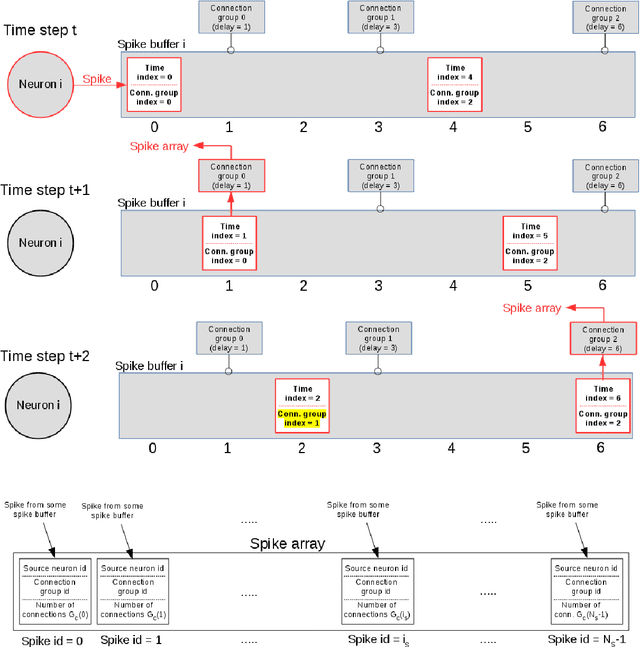
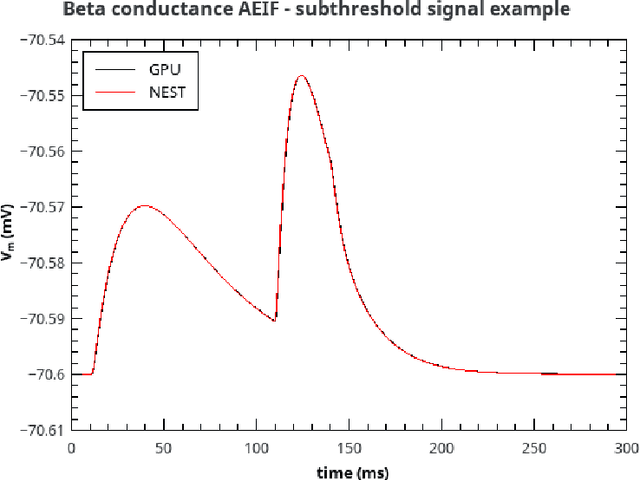
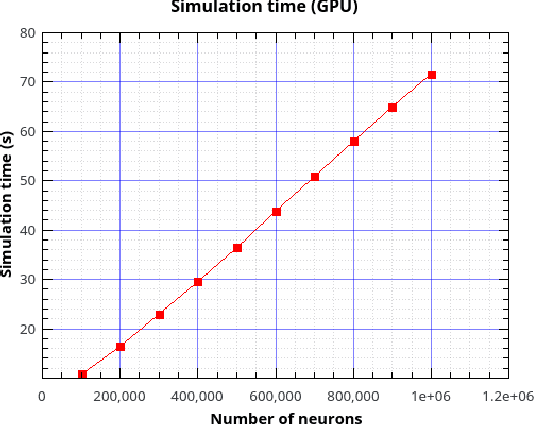

Abstract:Over the past decade there has been a growing interest in the development of parallel hardware systems for simulating large-scale networks of spiking neurons. Compared to other highly-parallel systems, GPU-accelerated solutions have the advantage of a relatively low cost and a great versatility, thanks also to the possibility of using the CUDA-C/C++ programming languages. NeuronGPU is a GPU library for large-scale simulations of spiking neural network models, written in the C++ and CUDA-C++ programming languages, based on a novel spike-delivery algorithm. This library includes simple LIF (leaky-integrate-and-fire) neuron models as well as several multisynapse AdEx (adaptive-exponential-integrate-and-fire) neuron models with current or conductance based synapses, user definable models and different devices. The numerical solution of the differential equations of the dynamics of the AdEx models is performed through a parallel implementation, written in CUDA-C++, of the fifth-order Runge-Kutta method with adaptive step-size control. In this work we evaluate the performance of this library on the simulation of a well-known cortical microcircuit model, based on LIF neurons and current-based synapses, and on a balanced networks of excitatory and inhibitory neurons, using AdEx neurons and conductance-based synapses. On these models, we will show that the proposed library achieves state-of-the-art performance in terms of simulation time per second of biological activity. In particular, using a single NVIDIA GeForce RTX 2080 Ti GPU board, the full-scale cortical-microcircuit model, which includes about 77,000 neurons and $3 \cdot 10^8$ connections, can be simulated at a speed very close to real time, while the simulation time of a balanced network of 1,000,000 AdEx neurons with 1,000 connections per neuron was about 70 s per second of biological activity.
Sleep-like slow oscillations induce hierarchical memory association and synaptic homeostasis in thalamo-cortical simulations
Oct 24, 2018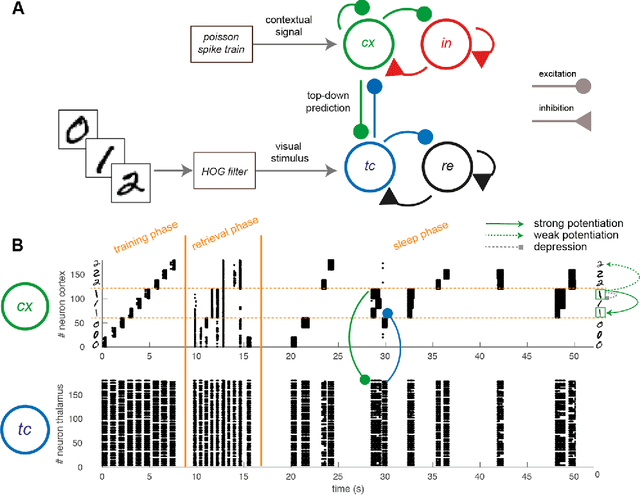
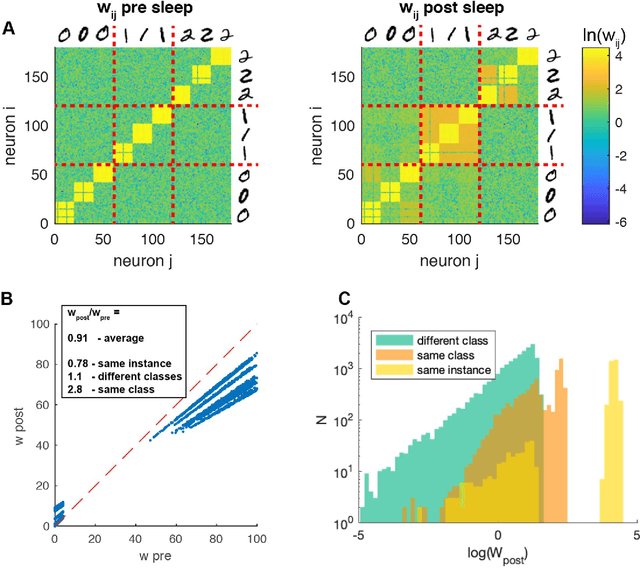

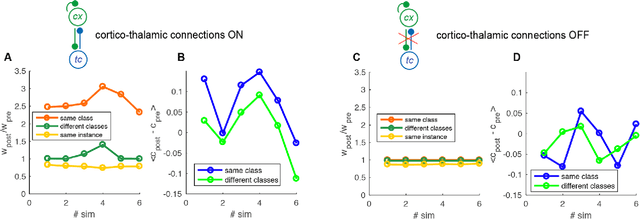
Abstract:The occurrence of sleep is widespread over the large majority of animal species, suggesting a specific evolutionary strategy. The activity displayed in such a state is known to be beneficial for cognitive functions, stabilizing memories and improving the performances in several tasks. Despite this, a theoretical and computational approach to achieve the understanding of such mechanism is still lacking. In this paper we show the effect of sleep-like activity on a simplified thalamo-cortical model which is trained to encode and retrieve images of handwritten digits. We show that, if spike-timing-dependent-plasticity (STDP) is active during sleep, the connections among groups of neurons associated to instances of the same class (digit) are enhanced, and that the internal representation is hierarchical and orthogonalized. Such effect might be beneficial to the network to obtain better performances in retrieval and classification tasks and to create hierarchies of categories in integrated representations. The model leverages on the coincidence of top-down contextual information with bottom-up sensory flow during the training phase and on the integration of top-down predictions and bottom-up pathways during deep-sleep-like slow oscillations.
A cognitive neural architecture able to learn and communicate through natural language
Jun 22, 2015



Abstract:Communicative interactions involve a kind of procedural knowledge that is used by the human brain for processing verbal and nonverbal inputs and for language production. Although considerable work has been done on modeling human language abilities, it has been difficult to bring them together to a comprehensive tabula rasa system compatible with current knowledge of how verbal information is processed in the brain. This work presents a cognitive system, entirely based on a large-scale neural architecture, which was developed to shed light on the procedural knowledge involved in language elaboration. The main component of this system is the central executive, which is a supervising system that coordinates the other components of the working memory. In our model, the central executive is a neural network that takes as input the neural activation states of the short-term memory and yields as output mental actions, which control the flow of information among the working memory components through neural gating mechanisms. The proposed system is capable of learning to communicate through natural language starting from tabula rasa, without any a priori knowledge of the structure of phrases, meaning of words, role of the different classes of words, only by interacting with a human through a text-based interface, using an open-ended incremental learning process. It is able to learn nouns, verbs, adjectives, pronouns and other word classes, and to use them in expressive language. The model was validated on a corpus of 1587 input sentences, based on literature on early language assessment, at the level of about 4-years old child, and produced 521 output sentences, expressing a broad range of language processing functionalities.
* The source code of the software, the User Guide and the datasets used for its validation are available in the ANNABELL web site at https://github.com/golosio/annabell/wiki
 Add to Chrome
Add to Chrome Add to Firefox
Add to Firefox Add to Edge
Add to Edge